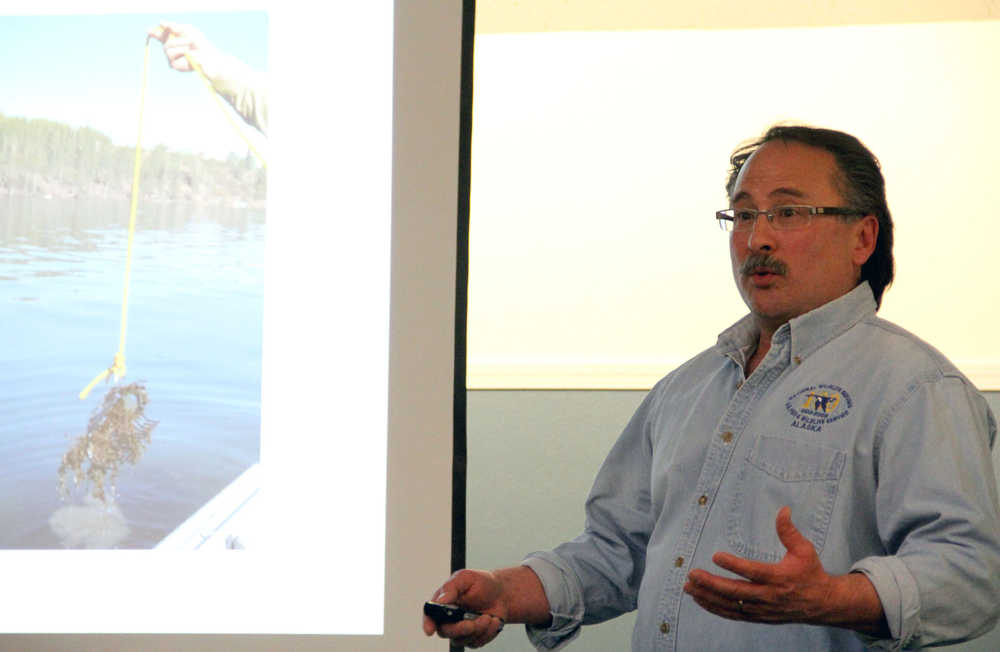While some details still need to be finalized, a team has prepared a plan to eradicate elodea, an invasive aquatic plant, from three Nikiski area lakes.
Members of an elodea subcommittee of the Kenai Peninsula Cooperative Weed Management Area presented their plan to landowners along the lakes at a meeting in Nikiski on Thursday.
One uncertainty with the plan is exactly how much money the project will receive. In the capital budget passed by lawmakers Friday, they included $400,000 for the Kenai Peninsula Borough elodea eradication project. John Morton, supervisory fish and wildlife biologist with the Kenai National Wildlife Refuge, said while Gov. Sean Parnell could veto the allocation, he’s not “too worried about it.”
The committee has received $190,000 to date for eradication treatments. The three-year eradication plan for the three lakes is priced at $597,000. If Parnell scratches the project from the budget, Morton said the plan would be scaled back.
Treatment for Beck, Stormy and Daniels lakes is scheduled to begin this summer. If the project doesn’t get the $400,000 from the state, Morton said crews would probably try to complete the full treatment for 2014 in only one lake.
Because elodea is prevalent throughout Beck and Stormy lakes, the subcommittee plans to treat the two water bodies in their entireties. It is believed Daniels Lake was infested more recently than the other two lakes because it has less elodea, so the subcommittee has determined a partial treatment should be sufficient, Morton said.
“Maybe just maybe we can knock this thing out given that it’s only in the three lakes and it’s not in the rest of the peninsula,” he said.
For Beck and Stormy lakes the subcommittee has determined to treat the lakes for the first time with both a pellet and a liquid form of the herbicide fluridone, which has been used to eradicate elodea in the Lower 48. For the following three treatments — in the fall of 2014 and springs of 2015 and 2016 — the subcommittee plans to treat the lakes with only the pellet form of the herbicide.
The subcommittee plans to use fluridone produced by SePRO Corporation called Sonar Aquatic Herbicide.
At the meeting, representatives with SePRO said the product has been tested by the company as well as tested and approved by the U.S. Environmental Protection Agency. They said the product, which will be applied well below the EPA’s maximum contaminate level, is not harmful to people or animals. However, it may have some effect on native aquatic plants.
The herbicide works by restricting the production of the plant pigment carotene, which is involved in photosynthesis — the process of converting light into energy.
In Daniels Lake, the subcommittee plans to treat five infected areas using only the pellet form of fluridone and possibly the herbicide diquat as well. According to the subcommittee’s Integrated Pest Management Plan for Eradicating Elodea from the Kenai Peninsula, diquat is fast-acting and is absorbed by the leaves where it is applied to interfere with cell respiration. Diquat is considered a “moderately toxic material” by the EPA, according to the management plan.
Morton said diquat is a contact killer that doesn’t eradicate elodea, it just sets it back, but the subcommittee is considering using it so the elodea doesn’t spread and require a whole-lake treatment in Daniels Lake.
Morton said the subcommittee wants to begin treatment soon after ice-out because water levels are low and the water is clearer.
He said ideally, crews would apply the first treatments in early June in Beck and Daniels lakes. If the state money comes through, treatment for Stormy Lake would begin in July. Morton can’t set an exact date for application because crews need a day when wave and wind action is low.
The subcommittee is also waiting for approval on permits from the Alaska Department of Natural Resources and the Alaska Department of Fish and Game before it can begin treatment.
Elodea eradication has not been done in Alaska. Lakes in the Anchorage, Fairbanks and Cordova area are also infested. Elodea, which is commonly used in aquariums, can reproduce with sections of the plant. Boats and floatplanes have been identified as likely accidental transporters between lakes.
Morton said crews surveyed Bishop Creek along with 68 lakes on the peninsula last summer and no elodea was found.
He said Bishop Creek is a concern because Beck and Daniels lakes flow into the creek.
“To the best of our knowledge Bishop Creek is not contaminated,” Morton said. “I think that’s just pure luck because I’m fairly certain there are fragments going out there and we may have just been lucky that it hasn’t gotten established yet. It’s a time bomb.”
Morton said the subcommittee believes the elodea infestation originated from the same source because all three lakes have the same elodea hybrid. He said the infestation on the peninsula likely began in Beck Lake because elodea is very abundant there.
Kaylee Osowski can be reached at kaylee.osowski@peninsulaclarion.com

